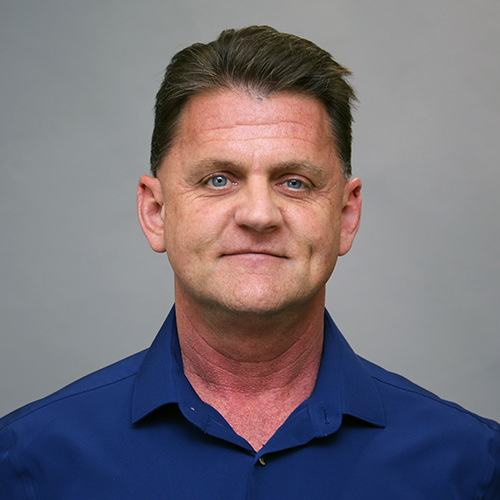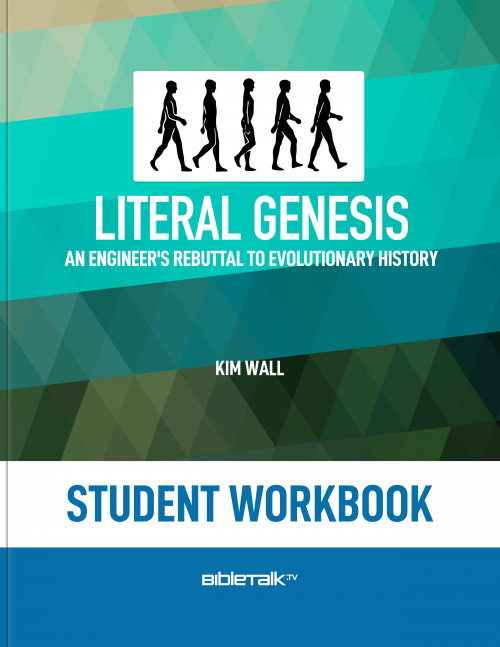Evolution's Extinction Engine
Part 4 – Energy
Welcome back to our series on Literal Genesis, where we strive to hold firmly to scripture and hold loosely to theories, and in particularly this theory of evolution, this macro evolution of how rocks and dirts can become people, and humans, and basketball players, over eons of time. This is the part that we want to hold loosely to because number one, the Bible doesn't say that's how God brought things about. We talked about this in previous lessons. It's a very cruel way to bring about life, not at all within God's character. And secondly, these theories change all the time. As we learn more and more about life and what life is. Life is one of those things that's hard to define. There are two or three things in the world of science that if you ask someone to define, it's going to be very hard for them to come up with an explanation. Life is one of them. We'll look at another one here in just a moment. So we want to hold loosely to those theories. We don't want to hold on so tightly to those and compromise scripture. We've seen in previous sessions that that leads to a bunch of theological inconsistencies.
Today, however, what I want to do is to go a little bit deeper. So last session we looked at four dimensions of the genome and how it folds itself and puts the instructions close together, that need to be. We also looked at alternative splicing, if you'll remember. It's just absolutely amazing. And how those have all the hallmarks of intelligent design to take a finite amount of space and to have so much information in there, and how do you efficiently access that information. It's absolutely jaw dropping.
Energy
Now today, we want to talk about energy. Energy is kind of like the word life. If you ask a physicist, for example, how would you define energy? Well, you can get a definition of what it does and maybe how it works, but what is it? What is the essence of energy? Nobody knows.
Same thing for life. What is life? Well, you can kind of get a definition of life, but what exactly is it? It's just one of those things that is really hard to pin down. But we're going to look at how we generate energy within our cells.
We can't do anything without energy. In fact, energy, here's the definition: is the ability to bring about change or to do work. Very, very simple. So don't think about how those initial rocks and mud turned into biogenesis, turned into some kind of living thing, but we're going to start with the living thing. I don't think rocks and mud do turn into living things, but that's another session. But once you have that living thing, that first cell, that single cell, that's got DNA, it is fully functioning, reproduces itself, can take nutrients in from its environment, how does that cell change over time to become plants, and animals, and insects and all the way up to humans? How does that happen? Well it doesn't happen without energy. Nothing happens without energy. If you're going to have anything happen at all, you need energy. So that's why I want to kind of focus in on this idea of energy. In fact, no living or manufactured thing exists on the planet without energy.
Try to think of one example of any manufactured thing or living thing that doesn't require energy. You have to have energy. Now you may have heard of this phrase no free lunches. When I talk to younger generations sometimes, I'll ask them if they know what this means, and I get a lot of blank looks. I guess it's one of those phrases that may have fallen out of our vernacular, but no free lunches means nothing in life is really free. And particularly when we're talking about this idea of energy, where does energy come from and at what expense? Because energy can't be free. Where does the single cell get its energy for all those innumerable steps that it must have gone through, if evolution is true, to change from a single cell into a human being? And all of that has to happen with energy at every step so, no free lunches. We're going to investigate where this energy comes from and get a little better idea.
The Fuel of Life
Now today, I love this part, this is the best part. Food. Who doesn't like to eat food? And as humans we can take in meat and potatoes and turn that into energy. In fact, nearly everything that we eat eventually winds up as glucose, almost everything we eat. It's kind of amazing. And our body is able to take that glucose and transform it, somehow, into a form that the cell can actually use for energy. That's the part I want to focus in on today.

In fact, cells, they take that glucose from those meat and potatoes and they turn it into ATP. Now that stands for Adenosine Triphosphate. It's a long name for a chemical, a very small chemical. And in the image above, you can see this adenosine triphosphate here. Particularly, you can look at the three structures hanging off to the left. That's the tri part. Tri means three. These are three phosphate molecules.
Okay, so how does the cell take ATP and use it for energy? Kind of like we would for gas in an automobile. Well, at a very high level, whenever you have three of these phosphates together, it's like having three kids in a room where two of them get along really, really well, but nobody likes that third kid because, I don't know, maybe they're a bully or something like that.
Well the same thing here with these three phosphates. This last phosphate wants to go, wants to be free. So think of it like a spring that you compress down and in that spring's compression state, that's the three phosphates. And so when this third phosphate is broken off, it finally gets to be free, the spring can unload and move into a relaxed state. And that process of unspringing, becoming uncompressed, that produces energy.
That's very similar to what happens here in the cell. The cell is able to cleave or to break off this phosphate, this third phosphate, and it produces energy in the process. And the cell is able to harness that energy.
So when we're talking about ATP, adenosine triphosphate, this is what we're talking about. And it all starts here with this marvelous process of food and taste buds. Have you ever thought about that, why did God give us taste buds? It's not necessary. We could have taken in meat and potatoes and not have any enjoyment out of that at all. But we do. It's a very pleasurable thing to experience food. Okay, enough about food.
ATP Synthase
What engine, what motor inside of the cells creates this ATP? Now, like in life, we know that gasoline runs our automobiles. If we trace it back to its source, that's from fossil fuels. We mine them out of the earth, we refine them and put them in gasoline, put it in our cars and then we go. Well this is the motor, this is the thing. It's called ATP synthase and it is a molecular motor.
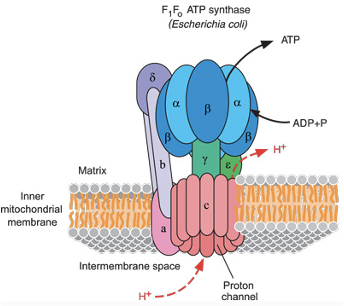
Now, just like the motor we looked at on the bacteria flagellum that powered its tail to give it movement, this also has stators and rotors in this engine. There are parts that are stationary, there are parts that rotate. And if you look at the orange and gray matrix here, this motor is embedded in the lining of what we call mitochondria. It's kind of a tiny little organ inside of our cells. There's lots of these inside of our cells. And inside of this mitochondria- think of mitochondria as a power plant, and one of its jobs is to produce power for all of the cells, for the rest of the cells.
The inside of mitochondria is kind of double-walled. So you have an outer wall and you have an inner wall and inside of this inner wall, this motor is split between both sides of this wall, the way this motor is situated in the matrix. And what powers this motor are protons. And we'll look at this more in detail here in a moment, but these protons that are inside of this inter matrix, they want to go to the other side. Why do they want to get to the other side? I feel like there's a joke here somewhere like the chicken that crossed the road. It's no joke. There's protons on both sides of this membrane and whenever you have a discrepancy in the amount of protons on one side or the other, the protons naturally want to go to equilibrium. They want to even it out on both sides. So if you have a lot of protons down here and less up here, they want to go to the other side. That's just how things work in chemistry usually. And so when protons enter this tunnel into this motor, this is what drives the motor, turns the motor.
Okay, so far so good. These protons are very, very tiny. We're talking exquisitely small architecture. And when this motor is turned, what it's doing is it's taking these two chemicals and it's mashing them together to produce ATP. This ADP is Adenosine Diphosphate. Don't worry, there's not going to be a test after this. But di means two. So it's taking two- remember, we talked about ATP has three of those phosphates? Well ADP only has two. So it's taking the extra phosphate here and inside of this part of the motor, it kind of mashes them together, compresses that spring.
And then what is produced is ATP. Now there are thousands of these inside of the mitochondria, inside of all of our trillions of cells. So imagine all the ATP that's being produced right now. Even if you're sitting perfectly still, you're thinking. ATP is used in that electrical process that fires our synapse. It's used to move our muscles, it's used to walk. It's used for all of the activities that go on inside the cell. We'll look at this in a future session, but the cell is like a city. It's got roads, and highways, and post offices, and waste management, and workers and all these things require energy. Every single step, no free lunches. Everything requires energy inside the cell, and so you've got thousands of these producing this ATP.
In fact, one cell out of your trillion holds about a billion ATP molecules. That's a lot of gas cans. Now this motor is extremely efficient. When I talk about motors and efficiency, it may help to compare this to- what's the most efficient automobile engine that we have today? I believe it's the Mercedes-AMG Formula One, where it's got an efficiency of 50%, meaning 50% of the power actually goes into the car and 50% is lost. It dissipates as heat. Engines get hot. So it's 50% and that's the best that we have in an automobile.
This motor is nearly 100% efficient. We don't know how to make things like that. 100% efficiency. In fact, every one turn of this motor produces three of our ATP gas cans. Every one turn produces three ATPs powered by tiny, tiny little proton molecules.
And as I mentioned before, each of our cells can contain one billion of these ATP molecules. We're talking very, very microscopic here. And if you were to weigh one single ATP molecule, it would be the decimal .00000... It would be so small it would weigh next to nothing. Yet your body produces so much of these that it equals your weight every single day. So in a 24 hour period, let's say you weighed 150 pounds, you're producing 150 pounds of ATP.
Now wait, Kim, are you trying to tell me at some point in a day I weigh 300 pounds if I'm normally 150? No, it doesn't work like that. These gas cans are being emptied almost as soon as they're made. So you don't feel the extra weight. We're good there. However, something very interesting about ATP is we can manufacture this ourselves. In the lab we can take the molecules, we can mash them together. But if we were to do that, it would actually cost us around $1.4 million every single day for one person. If you were to make this yourself in the lab, it would cost you about $1.4 million. Yet your body does this on meat and potatoes. We should be very thankful we have this process.
Okay, I want to take a little closer look at what leads up to this motor. So we kind of got a basic understanding of how the motor works. Now again, thinking about our two alternatives: either this is designed by an intelligent creator, or this somehow assembled itself completely by accident over eons of time by that blind three-year-old making changes to the manual. I don't know about you, I'm going with the intelligent designer. Just because I'm a Christian, I've said this before, doesn't mean I'm going to check my brain at the front door when it comes to science. That makes no sense to me. That's not experiential. That's not evidential. This has all the hallmarks of intelligent design. There's specified complexity here. Things like this don't build themselves by accident and random chances.
Now there are several chains here that happened before this that I want to go into to kind of give you a little bit of a bigger picture. Actually, there's a much bigger picture that starts with the meat and potatoes and digestion and goes through all that and the enzymes unlocking the calories and all the things that have to be transported just to get to what I'm about to show you. But what I'm about to show you is still pretty, pretty crazy.
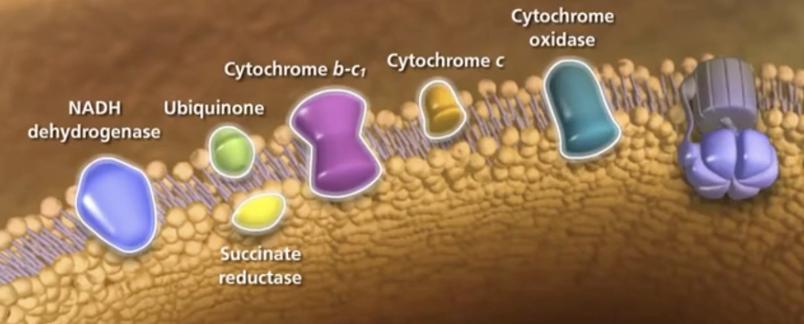
And so let me kind of explain what's going on here. You'll see these larger molecules.There's actually four of them, the fourth one here being the ATP synthase. That's the motor that produces the ATP gas cans, if you will. These other molecules here, these are acting like pumps. What are they pumping? Well remember the protons that I was talking about that actually flow in here that run this motor? These protons are pumped from one side of the membrane to the other. So you need these pumps in order for this to work because you need the protons to be able to flow into the motor. If all the protons are down here, it doesn't work. We have no energy. There's no life. Somehow you have to get the protons on the other side of the wall and that's what these pumps do.
Now, how are these pumps powered? If this is making ATP, what powers these pumps? You're going to find this hard to believe: electrons. As those meat and potatoes get digested and broken down, there are little carriers- you're going to see it in the animation in a moment- that come in here and carry these electrons broken down from the food process. They're going to donate an electron to these pumps and that's what powers the pumps.
We're going to look at that in a little bit more detail on the next slide. What I want you to pay attention to is the shuttling of these electrons. This pump will use it, it'll shuttle. It'll come over here. This pump will use it, it'll shuttle. This pump will use it. And at the last site here, when this pump is done pumping the protons across the gradient, it needs to get rid of its electron and it actually combines with some oxygen molecules to create two molecules of water.
This is the whole reason we breathe right here. This electron has to attach to something at the end of this process or it doesn't work. Oxygen needs to be there. This is why it's important to breathe. We all know it's important to breathe, but this is why. This oxygen molecule makes its way here so that it can take that electron when it's finished and create water out of the process. Now these two shuttle enzymes here, this ubiquinone- oh, by the way, this is another name for CoQ10. Does that sound familiar? If your doctor has prescribed you coenzyme Q10 or CoQ10 and you're wondering what does it do, pay attention. This is what CoQ10 does: Its job is to shuttle electrons between these pumps. Very, very important. Okay, I'm going to play the animation and I may point some things out as we go along here, but this is called the electron transport chain. And you'll see why, because it's literally using these electrons and then kicking them over to the next piece until it gets to the end.
And now once you have all the protons or not all of them, but a lot of them up here, guess what? Now they want to go back. They want to go back across the wall because now you have a concentration of the protons up here and this is the only way they can get to the other side. And as they're going through ATP synthase, they power it and it creates ATP.
Okay, we'll play the video here (see video 18:10) and you'll notice these helper enzymes coming here on the side here in a moment. They're going to donate their electrons to this pump. Then there's CoQ10 moving it to the next pump. There's cytochrome C moving it to the next pump. You'll notice these protons moving from the bottom to the top. There's our three pumps working. Now the protons want to come back to the other side. They have to go through the ATP synthase enzyme or engine and that's where ATP is made. That's where the fuel is made.
This is a tiny part of the process of meat and potatoes finally getting down to single electrons running this electron chain and then powering the ATP synthase motor. Can you imagine, no matter how much time you have, that this process could build itself? Now I know, I've talked to biochemists before and yeah, these things are attracted, and those things are attracted and I understand how basic chemistry works. But we're not talking just basic chemistry. We're talking about a system that works together and where do these things come from? We're going to look at that here in a couple slides. All this is so integrally tied together, and tied back to DNA, and tied to energy and tied to enzymes that there's no way this process could come about step-by-step.
First of all, it's never been shown. You can't show it. There's no paper that shows that this can even be done. But this, again, has all of the hallmarks of intelligent design. A mind designed this system. That's the best possible explanation. That's my opinion, of course.
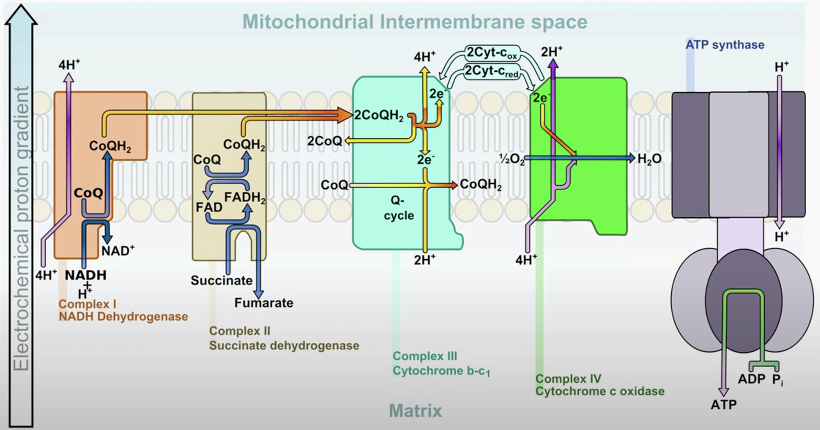
Above is an image of the same process, only laid out in a two dimensional diagram. We're not going to go through this. This isn't a chemistry class or biochemistry or anything like that, but you see the pumps that we are talking about here, then the ATP synthase and all the things that have to be just right.
And by the way, things like pH, when we talked about pH in the cell, everything has to be just right for all this to work and for this to be transferred from one station to the next, these pumps that pump those protons from one side of the gradient to the other. It looks complicated. It's not as complicated as it may seem here. But the idea is this could happen- a blind three-year-old could build something like this over time? Come on. I don't think so.

Now, one of the parts I'm going to hone in on is what we call these redox centers. This is a pump, this ominous dark structure here, is one of those proton pumps. And when these electrons are shuttled over to the pump, here's what actually happens inside of that pump: these electrons kind of bounce back and forth off of these centers. The electrons are the light blue and these redox centers are purple and the electrons want to move from higher to lower because it has to do with the affinity of chemical properties inside of the pump. We don't need to go there. Just know that the electrons want to go here. They want to go here. And every time they make this hop into one of these little mitts that catch them, these redox centers, there's a little bit of energy released from this electron.
So energy, energy, energy, energy. We have seven drops here, so seven energy drops and all that energy is harnessed by this pump and used at the same time once it has enough energy to, guess what? Pump protons across the gradient. This is so intricate. Think about how small an electron is. Think about if this process didn't work or if there weren't enough of these redox centers to capture all the energy, because every time it's captured, it releases energy.
Well, what if the electron skipped these steps? You wouldn't have enough energy. You wouldn't have energy to power the pump. You couldn't get the protons across the gradient. Then you wouldn't have any way of powering the ATP synthase. It's all so delicately tied together. It's just unfathomable to believe that this could be the process of blind chance. This is a system. I'm an engineer. Anything that I engineer is not based on chance, believe me. It's very, very thought out.

Alright, how small are we talking about, this ATP synthase? If we look at a dime and look at the edge of a dime, that's typically about one millimeter. So we asked the question: How many of these ATP synthase motors can we stack on the edge of this dime, going from the bottom to the top? And the answer, it's about 100,000 of these engines. This is the level of smallness that we're talking about. 100,000 of these motors can fit in about a millimeter stacked one on top of the other. We can't create technology like this.
Now you may be thinking, whoa, wait a minute, what about microprocessors? There's billions of transistors in a very, very small space. That's transistors. This is a motor, a working motor with moving parts. We don't know how to create things like this, but somehow nature figured out how to do it by accident at this scale over eons of time? Again, that doesn't make a lot of sense to me. Now even the most "simplest", and I put that in quotes, single cell, because if it's a cell and it's alive, it's not simple. There's nothing simple about life at all, but even the most simplest cell runs off of ATP and requires this process.
Remember, in a previous session, we talked about the MO1 bacterium with all of its tails and how supposedly they found that in rock that was three billion years old? The Cambrian explosion, if you remember that from your science class was like 500-550 million years ago. I don't believe in the timescale, but if you believe in evolution, if you believe in that ideology, that's fine. I'll still like you after the class. That's okay. But now you have to go back three billion years and you've got this process in place, this complex ATP synthase process with these tiny, tiny molecular motors running off of electrons and protons. How did that get there that far back? Every living thing requires it. Now here's where someone might say, "Well, life back then was simpler. It had simpler ways of making energy for itself. This has evolved over billions of years of time."
Well, that just creates other questions in my mind. If these first living cells were simple and operated off of simple, simple machinery, where do the machines come from? That's another question. But let's say that happened and some of those cells evolved into plants, and reptiles, and mammals and man over time. Are you telling me that simultaneously across all these living things, they all developed ATP synthase individually? That's even more improbable than the first single cell having it to begin with. Lots of problems. And by the way, the instructions for building these components, this motor, guess where they are? They're in the DNA.
Critical Thinking: In Evolution, Which Came First?
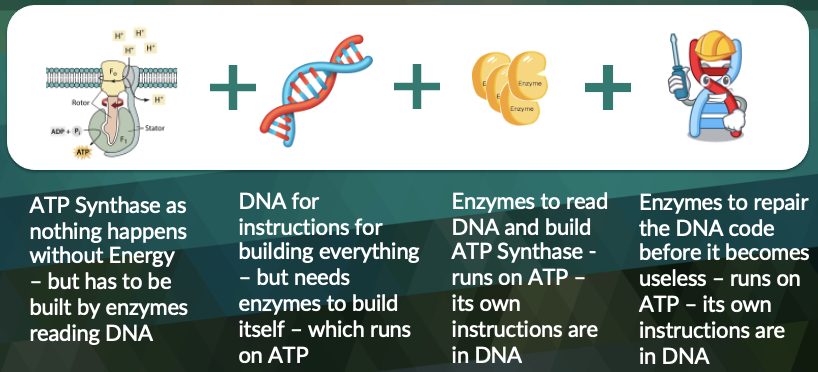
I want to ask this question. This is a very important question. Let's just start with the ATP synthase motor, this tiny, tiny, little motor that fits 100,000 of these end to end on the edge of a dime. This is a motor, another way of looking at it, with our rotors and stators and the ADP making ATP, the protons going through it kind of powering the pump. So nothing happens without energy. We said that. There's no free lunches. If a single cell is going to evolve somehow over millions, billions of years, whatever it is, then you need energy along every step of the way. This is how living things get their energy. Now the instructions for making this is in the DNA. Who builds this motor in early life? Where do they find the instructions? Well, they find the instructions in the DNA.
So we have the motor, we have the instructions for the motor. Everybody clear on that so far? Alright, we have a motor, the instructions for the motor. Well, obviously we need someone to read the instructions to build the motor. The instructions for the motor are in the DNA. The workers can read the DNA and build the motor. Makes sense. We need these parts. Kind of like having all those manuals of the airplane in our hanger and having no one to read it or skilled enough to know how to build from it. It's the same thing in DNA. You need those workers. Enzymes can read the DNA and they can send the instructions to factories and factories can build the parts. That's how it works in the cell. The instructions for building the enzymes are also in the DNA.
And you may be a little confused at this point. I hope so, because this is confusing. Oh, and by the way, we have a repair worker that repairs the DNA as errors happen. And remember, we talked about in a previous session, how one quintillion errors happen in our cells every day through this copying process and if it weren't for these workers repairing those errors, we wouldn't live very long. They are very essential. Oh, by the way, the instructions for building these workers are in the DNA.
Let me see if I can get this straight. Enzymes build the workers based off of a blueprint in the DNA. They build the repairmen based off instructions in the DNA. The instructions for the enzymes are in the DNA. Enzymes must build themselves using instructions in the DNA. Nothing happens without energy. We need to build these motors whose instructions are in the DNA that must be followed by the enzymes. Let me ask this critical thinking question. Which of these came first in the evolutionary ideology? This is not a question you can just sweep under the rug. I've talked to many people who are very strongly educated, some scientists, and you just can't say, "Well, things spontaneously arose in the cell."
How did this happen? How did this system come together when every one of these parts are needed at the beginning, from the very beginning? Without repair, nothing would last very long at all because of the copiers. Without workers, nobody would be able to read the DNA and without energy, nothing happens inside of a cell. How do you get all these things right there at the beginning from the very first living cell? Well, I have an answer for that: God spoke and it was. This is a product of an intelligent mind. Again, science, when you carry it out, does not lead to a disbelief in God. Not at all. But the more knowledge we have of the cell, the deeper we go, the more things that we learn, it's just absolutely fascinating.
And I've said it before. Those goalposts of that evolutionary ideology, they just go so far out. They just keep getting pushed back and pushed back. We're never going to get there with that ideology. And by the way, I'm not the only one who thinks that. There are different theories, well there are always different theories, but we always talk about this Neo-Darwinian theory, this macro evolutionary theory, molecules-to-man type theory, this Darwin base, but it's neo, it's new. It's been modified. We've added to it. And we think, well, that must be the answer. That must be the way things happened. But did you know there's other ideas as to how life came about? It's kind of all built on Darwinism a little bit, but a little bit different.
Why have these other theories, if this theory is so good and it works? Well it doesn't. And that's why there's all these alternative theories. Science does not lead to a disbelief in God, but rather disbelief in atheism. There has to be an intelligent mind. Now, if you want to go with the alien, rocket ship hypothesis, that's okay. I won't necessarily hold that against you, but be a critical thinker. Ask the tough questions. Where did that life form come from? What are they made of? What's the evidence that that even happened?
And back to our anchor verse, Psalms 139:14,
"I will give thanks to you," to God. Why? "For I am fearfully and wonderfully made."
- Psalms 139:14
We watched a very short snippet, an animated video, of these electrons being passed back and forth by these enzymes powering these pumps that eventually leads to manufacturing of ATP in the cell. That is amazing. David had, I'm assuming David had, no idea when he wrote this that that's what was going on inside of his cell. And he goes on to say,
"Wonderful are your works and my soul knows it very well."
- Psalms 139:14
Again, "Wonderful are your works." And though personally for me, it is so gratifying the more I study biology and look in the cell at all the things that go on on a daily basis, happening right now as we're in this room. It just absolutely boggles the mind. Personally, I'll give credit to my Creator, that wonderful are His works. He has designed this. And I want to close with this scripture here, Matthew 11:28-29, where Jesus is speaking. He says,
"Come to me all who are weary and burdened and I will give you rest. Take my yoke upon you and learn from me for I am gentle and humble in heart and you will find rest for your souls."
- Matthew 11:28-29
I want to focus on the last part of that verse, "You will find rest for your souls." You know, it's great that we can get energy from meat and potatoes, or choose the diet of your choice. You're going to get energy from those nutrients. It's an enjoyable thing to sit down and eat a meal, and for this ATP process to be happening as we eat. It's absolutely amazing. But at times we get tired, don't we? We get tired and we have to rest and God engineered us to take rest.
It's not all about eating all the time and moving 24/7. We have to take our rest. And sometimes we need a vacation. We have to get away from it all. We're thinking too much and we just need to relax the mind. And those are good things. All these are good things. But Jesus is offering us something here that ATP synthase can't satisfy. What is that? That is rest for your souls. And when He says, "Come to me, all you who are weary and burdened," He's talking about a life of service, service to Him.
Not one that's difficult and weighing you down, like the leaders of His day, the religious leaders, but a way that, again, can renew you, give you rest in a way that ATP can not. And this would be my wish for everyone that I talk to, that they would find their Creator. That they would seek their Creator out and serve Him rather than devote themselves to a life of an ideology that just simply makes no sense and is lacking in evidence to support it.
That's going to wrap up this session today. Thank you very much for your attention. In our next session we will look at the second half of this equation. So far we've been talking about DNA and the things that could go wrong, the mutations part of evolution. The second part of that is natural selection. Well, what is that? How does that play into that? And how does that affect the evolutionary engine? Does it help? Does it hurt? Stay tuned for next session and we'll find out.
Thank you.


